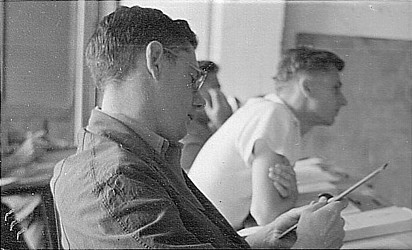
 |
|
The Postmaster General's Department ran a five year training scheme in telecommunications and allied fields such as radio, in which it accepted trainees at secondary school level. However at one stage they ran three courses of the same technical content for adult entrants who had some previous technical background. This article revives a bit of history about those Adult Technician-in-Training courses.
Introduction Up until more recent times, the PMG's Department controlled national telecommunications and at that time, probably employed more technicians with telecommunication, telegraph and radio skills than any other single organisation in Australia. To support the need for technician recruitment, they ran training schools in which young trainees attended courses and had practical training over a five year period. In the earlier years, the course concentrated on theory and in the latter years more time was spent working practically at different stations to obtain a range of experience. Also in the latter years, they were grouped into one of the specialised three fields of Telephone, Telegraph or Radio in which subjects were taught specifically related to those fields.
During the War years and some years later, telecommunications and radio systems expanded rapidly and so did the need for technicians in the PMG. Many technicians, with some form of suitable experience, were initially recruited from outside of the Public Service. When the war ended, there were returned servicemen who had gained relevant technical experience in the armed services and many of these were also recruited.
Long time technical staff anticipated becoming permanent members of the Australian Commonwealth Public Service but the new recruits were employed on a form of temporary basis and called Exempt Technicians. Apparently they were exempt from provisions of the Public Service Act which provided limited tenure for temporary employment.
Adult Technician-in-Training Over previous years there had been open examinations held to allow such Exempt Technicians and others outside of the Service, to qualify for permanent status. However to cater for the large influx of Exempt Technicians, the Authorities set up a new way. Fairly basic technical examinations were set for the permanent appointment as Adult Technician-in-Training ,the first of which were held on November 9, 1946.
The list of successful applicants, resulting from the exam, was published in the Commonwealth Gazette, February 9, 1948. The list for the whole of Australia numbered 406 including 42 in South Australia. The course commenced in South Australia early in 1948 with 35 trainees as shown in the photograph, figure1 . (I was one of the 35 and one of several who had previously worked in the PMG Transmission Laboratory - Refer OTN 47, March 2011.)
I can only speak for South Australia. But considering the large number of applicants who qualified in the Eastern states, there must have been a lot of adult trainees throughout Australia at that time.
At the start of 1948, the PMG Technical Training school moved into several floors of Simpson's Building in Gawler Place, Adelaide. This is where we were based. .
The Adult course consisted of the same subjects and practical instruction as given to the young trainees who commenced at school leaving age. However, the course had to be completed in two years instead of the five years for the young trainees. This was achieved to a large extent by reducing the field experience at different stations. This reduction was justified as all of the adult trainees had previous field experience before appointment as trainees.
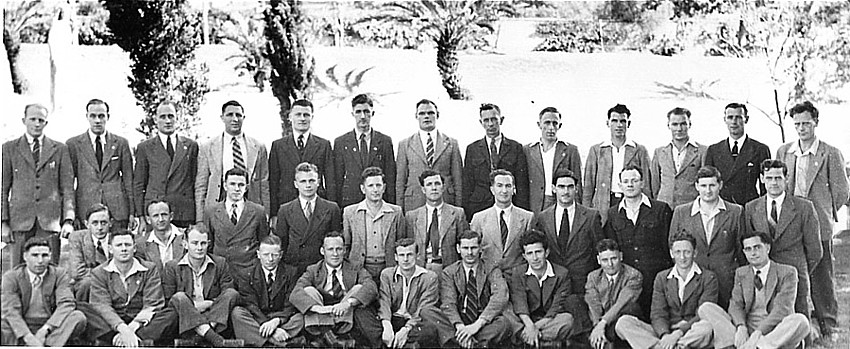
|
The Adult Tech-in-Training Group 1948 Left to Right Standing - K.G. George: J.S.L. Turner: R.A. Nielson: E.J. Manoel: D.W. King: R.P. Mills: F.R.H. Holker: R.E.C. Wilson: H.W. Crouch: J. Steer: H.A. Deere: W.H. Pugh: J.A. Spurr. Kneeling - H.W. Couston: G.L. Howie: A.J. Rose: K.N. Fathers: W.C. Coles: B.L. Carr: R.L. Green: K.D. Retallick: E.M. Tonkin: S.G. Wass: F.K. Elder. Sitting - M.J. Coulson: T.L. Pettman: R.W. Burton: A.R.J. Moxon: W.J.D. Baldock: A.L. Butler: W.R. Nottage: L.C. McCarthy: J.L. Flaherty: T.S. Harrison: M. Osborne. |
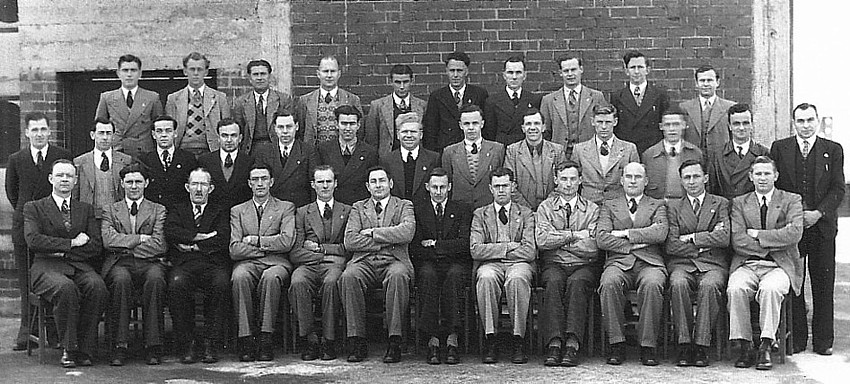 |
The Adult Tech-in-Training Group 1949 Left to Right Back Row: Jack Jerram, Ron Payne, Bill Maley, Max Crossman, ? , ? , Harold Williams, ? , Colin Caporne, Ken Townsend. Centre Row: Eric Menekino, Lindsay Mitton, Colin Schick, Les Nelder, Russel Whetstone, ? , Barry Miller, Ross Webster, Ken Lund, Jim McCleod, Hurtle Waters, ? ,Jim Foster. Front Row: Reg Soane, ? ,Angas Young, ? , Geo Weinke, Jim Mollison, Graham Cameron, Keith Day, Evan Soukopp, Jeff Broomhead, Dudley Field, ? . |
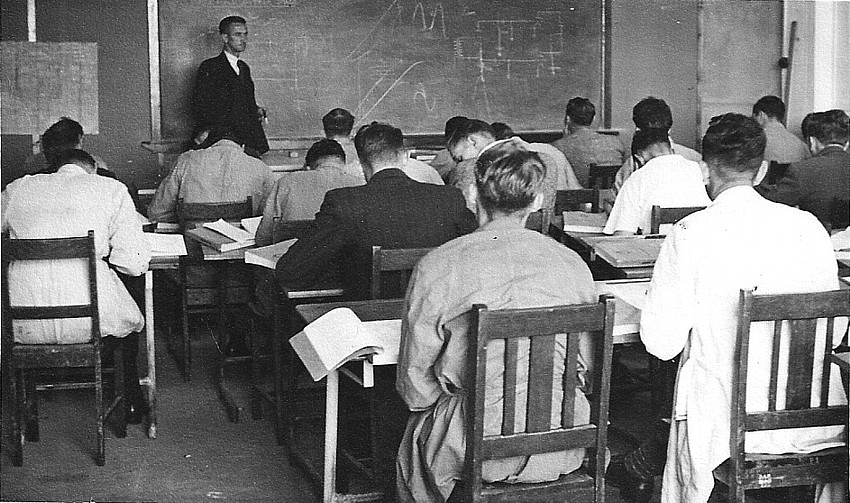 |
In Class - The Instructor is Phil White (One of our best) |
Of course we had our fun. We had a one new instructor, not used to dealing with mature students, who might have just known a little more about a particular subject than he did. He tried to bluff through something we all knew was wrong and declared that "if he was wrong he would parade down Rundle Street in his underpants". Of course he never did honour that undertaking.
For electrical technology experiments I had a partner who delighted in making the experimental boards blow up. South Australian readers may remember Gordon Howie (Figure 1, centre row, second from left) who became the bane of parking inspectors and local Councils by challenging many parking by-laws.
The list of trainees for the 1948 group is complete as shown in figure 1. However eight names are missing from the 1949 group of figure 2. I would be interested to update the list if anyone can identify any of those eight.
RAOTC published the original form of this article through its journal OTN. As RAOTC is an Amateur Radio based club, trainees from the 1948 and 1949 groups who have had amateur radio licences are identified:
Figure 1, Top Row, 6 from left - Ron Mills (VK5DM)
Figure 1, Front Row, 6 from left - Lloyd Butler (VK5BR)
Figure 1, Front Row, 7 from left - Ray Nottage (VK5MI)
Figure 2, Centre Row, extreme right - Jim Foster (VK5TX/VK5LU)
Figure 2, Front Row, 6 from left - John(Jim) Mollison (VK5MF)
Whilst the second Adult course started the following year after the first course, the third course started several years later. By that time, I had transferred to the Dept of Civil Aviation (DCA) and unfortunately I have no records to offer concerning the year of operation or detail of that third group of trainees.
The School Training Staff in 1948
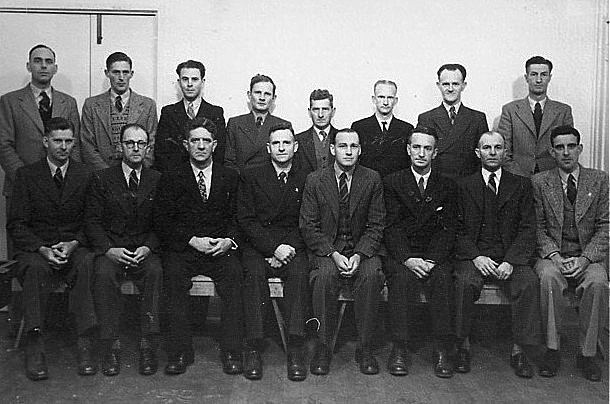
|
|
Standing: J.R.Hemer, R.N.Rowell, K.M.Prime, A.J.Love, L.B.Stanwix, R.S.Smith, A.K.Duncan, R.A.Burden. Sitting: C.E. Moule, H.W.Oehme, A.C.Anderson, J.H.Allen(Supervisor), D.F. Burnard,(Div. Engineer), P.S.White, I.J.Drayton, M.J.Pricent |
Where did the trainees go?
Most of the trainees qualified and became permanent technicians (and higher grades) in such areas as suburban automatic telephone exchanges, country stations, broadcast transmitters, the ABC studios and telecommunication or radio installation sections. Some trainees turned to teaching others.
In my particular case, I never filled the position of permanent PMG technician. I had already qualified in examinations in DCA and was promoted directly to senior level in DCA where I first supervised aeradio installations and then the SA/NT Regional Radio Workshops. In my last year at DCA I filled a position as technical instructor in the DCA school.
Eric Manoel (Fourth from left, top row, figure 1), also already qualified in DCA examinations, was similarly promoted. He began by starting the DCA Technicians school at Parafield which eventually moved to one floor of Simpson's Building where the PMG school was already placed. Ultimately Eric was offered the position of head of the Kilkenny Radio Technical College where he remained until retirement.
I guess the idea of teaching also rubbed off a bit on myself. For the year 1954, I assisted the work of Eric Manoel as a technical Instructor in the DCA school in Simpson's building. After moving on to what started as The Long Range Weapons Establishment, I also taught Radio & Electronics, one night per week for about 15 years at the SA Institute of Technology.
There were several others from the Adult Trainee Group who became teachers in the PMG school where they had previously been trained themselves . Referring to the school staff photo for 1958 at the end of this article, the following adult trainees for 1948 are included as part of the teaching staff: Bill Baldock, Reg Wilson, John Turner, Jim Spurr, Burnie Carr, Syd Wass, Max Osborne, & Max Coulson.
Re-union of 1948 Adult Technicians in Training at Aldinga in 1983
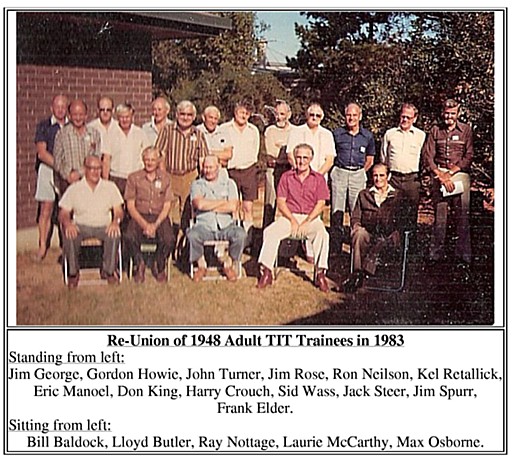
The School Training Staff in 1958
Recently (in 2016) Steve Garie has sent the following copy of the school staff around 1958 with the members identified. Many of them have come from the ranks of previous school trainees including many from the adult groups. It is interesting that our previous photo of the 1948 year, the school staff numbered 16. In the 10 years to 1958, the staff had doubled to 36.

|
|
Rear (from left): Korny Dronis (store), Fred Miller, Bill Baldock, ABM Smith, John Nugent , Ray Smith, Bob Bickford, Ken Bradley, C. A. Laurence, Max Crossman, Ozzie Tancock, Brian?? Harradine Centre (from left ) - Geoff Jenkinson, Ken James (Driver), Jim McIntyre (later Xbar king), Reg Wilson, John (JSL) Turner, Jim Spurr, Bernie Carr, Keith Duncan, Syd Wass, Ted Reilly, Wally Bradley, Alan Gooley Sitting: (from left): Reg Turner, Charlie (CT) White, Max Osborne, Keith Vawser (Group Engineer), Bill Oehme (Dep. Principal), Max Scriven (Divisional Engineer), Joe Allen (Principal), ABM White, Bob Rowell, Bill Glass, Reg Whiteman, Max Coulson |
So there ends my story. I wonder if any of our OTN readers went through these courses in the other States and can add something to this history.